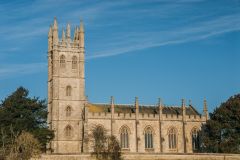
Churchill is a very pretty Cotswold village high on a hill. The soaring tower of All Saints Church (1827) is visible for miles around. The early Gothic Revival church is modelled after three Oxford colleges.
Clustered near the church are an attractive pub, golden-toned cottages, and a neo-Gothic fountain described by architectural historian Nickolaus Pevsner as 'hideously ugly'. Poet John Betjeman liked it, though - you can make up your own mind!
Churchill History
You would think that the reason for the village name is obvious, given the impressive church and its location on a hilltop, visible for miles around. You'd be wrong. The first part of the name comes from Old English 'cyrc', which loosely translates as barrow, burial ground, or hill.
There are barrow mounds in the area of the village, so it would seem that there was a settlement here in pre-Roman times. An alternative linguistic theory is that the name is simply a combination of the Old English and Saxon terms for hill, giving us 'hill hill'. Churchill was mentioned in the Domesday Book.

The history of Churchill changed dramatically on 30 July 1684, when a devastating fire swept through the village. Twenty timber houses burned down and four people died. Blame for the fire fell on a baker who connected her chimney to the house next door to avoid having to pay the chimney tax.
The old village site was abandoned and the village moved to the crown of the hill. When the villagers rebuilt their homes, it was in stone rather than timber - a case of wisdom in hindsight! All that remains of the old church at Churchill is the 14th-century chancel, which now serves as the Churchill and Sarsden Heritage Centre.

In the Heritage Centre, you can learn about William Smith, the 'Father of English Geology', who was born in Churchill in 1787. Smith was the first to create a geological map of the entire country. A memorial to him, erected in 1891, stands at the top of Hastings Hill. The memorial is made of stones found in nearby Sarsgrove Wood.
Another native of Churchill was Warren Hastings, the first Governor General of India and an associate of Clive of India. Hastings was impeached for corruption and spent most of his fortune fighting the charges. In a trial lasting seven years, he was eventually cleared. He bought the nearby Daylesford estate and is buried in the churchyard there. A commemorative tablet marks the house on Hastings Hill where he was born.

The Langston Memorial Fountain
Now, about that 'hideously ugly' fountain - it was erected in 1870 by Julia, the Countess of Ducie in honour of her father, James H Langston of Sarsden House, lord of the manor and local benefactor. The Grade II listed fountain (aka the Langston Memorial Fountain) provided fresh water to residents of Churchill who would otherwise be using water drawn from wells or springs.
The fountain was fed by a conduit from a spring at Conduit Farm and acted as a central distribution point, feeding into a network of standpipes and taps around the village. And it was needed, for Churchill was not connected to mains water until 1964.
The fountain is made of limestone set on a marble base. It is in the form of a short tower in Tudor Gothic style with an embattled parapet topped by corner pinnacles and a central crocketed spirelet. Below the parapet are a band of armorial shields. The west side has a recessed spout that empties water into a circular trough.
Is the fountain 'hideously ugly' as Pevsner claims? I don't think so, but then, I live locally, so perhaps I'm biased.

I've driven through Churchill more times than I can recall, and, honestly, every time I see the dominating tower looming into view I feel my heart lift, and I think, 'I could live here'. The church dominates the village like no other place I can recall.
The combination of the ornate tower, the lovely Cotswold stone cottages, and the picture-postcard pub across the road is one of the most idyllic sights in the Cotswolds.
About Churchill
Address: B4450,
Churchill,
Cotswolds,
Oxfordshire,
England
Attraction Type: Village
Location: On the B4450 south west of Chipping Norton
Website: Churchill
Location map
OS: SP285245
Photo Credit: David Ross and Britain Express
HERITAGE
 We've 'tagged' this attraction information to help you find related historic attractions and learn more about major time periods mentioned.
We've 'tagged' this attraction information to help you find related historic attractions and learn more about major time periods mentioned.
Historic Time Periods:
Find other attractions tagged with:
14th century (Time Period) - barrow (Historical Reference) - Domesday Book (Historical Reference) - Gothic Revival (Architecture) - Pevsner (Person) - Roman (Time Period) - Saxon (Time Period) - Tudor (Time Period) -
NEARBY HISTORIC ATTRACTIONS
Heritage Rated from 1- 5 (low to exceptional) on historic interest
Churchill, All Saints Church - 0.3 miles (Historic Church) ![]()
Churchill and Sarsden Heritage Centre - 0.4 miles (Museum) ![]()
Salford, St Mary's Church - 2.2 miles (Historic Church) ![]()
Chipping Norton, St Mary's Church - 2.4 miles (Historic Church) ![]()
Bledington, St Leonards - 2.8 miles (Historic Church) ![]()
Adlestrop, St Mary Magdalene - 2.9 miles (Historic Church) ![]()
Lower Oddington, St Nicholas Church - 3.1 miles (Historic Church) ![]()
Chadlington, St Nicholas Church - 3.4 miles (Historic Church) ![]()
Nearest Holiday Cottages to Churchill:
Chipping Norton, Oxfordshire
Sleeps: 4
Stay from: £550 - 2427
More self catering near Churchill











